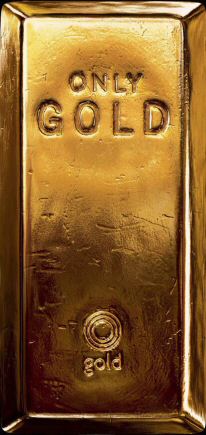Gold Demand Slips in U.S., Soars Globally in 2010
February 01, 11 by Courtesy National Jeweler Network
(IDEX Online News) - Gold demand fell slightly in the first nine months of the year in the United States, according to a newly issued report by the World Gold Council. Released last week, the WGC’s Gold Investment Digest for the fourth quarter and full year 2010 notes that the value of gold jewelry imports declined 8 percent in September year-over-year, an indicator that jewelry retailers were trying to manage gold inventory levels tightly for the holiday season as prices rose toward the end of the year.
According to the report, however, there was an increase in sales of gold pieces priced at $1,000 and up as affluent consumers released pent-up demand. The World Gold Council estimates that these high-end purchases could offset a decline in sales at middle and lower price points when all figures are tallied for the fourth-quarter, although sales volumes still are expected to register below 2009 levels.
Globally, increased investment demand and a rise in jewelry consumption, particularly in China and India, continued to push the price of gold upward in 2010, the report notes. For the year, the price of gold rose 29.2 percent, to $1,405.50 an ounce, by Dec. 30, marking a decade of continual increase. The average gold price rose 25.9 percent, from $972.35 an ounce, in 2009 to $1,224.52 an ounce in 2010. On a quarter-by-quarter basis, gold prices increased most dramatically in the second and fourth quarters, rising 2.6 percent, 11.5 percent, 5.1 percent and 7.5 percent in the first, second, third and fourth quarters, respectively.
While the sovereign debt crisis in Europe and higher inflation expectations helped to buoy investment demand for gold, global demand for gold jewelry also played a role. Gold demand for jewelry use rose 18 percent, to 1,468 tons, in the first nine months of 2010, compared to the same period in 2009, according to the report. In value terms, jewelry demand totaled $55.5 billion through the first three quarters of 2010, equal to the $55.5 billion spent during all of 2009, despite the measured increase in the price of gold.
According to the report, the increase in demand for gold jewelry is the result of continued economic growth and currency appreciation in countries that are key gold consumers-India, China and, to a lesser extent, the Middle East-and a growing appreciation everywhere for gold jewelry as both a luxury good and a store of wealth.
India remains the world’s leading gold consumer, and it exhibited the strongest recovery during 2010, with gold jewelry consumption up 73 percent, to 513 tons, through the first nine months of the year. Gold jewelry demand also rose in Hong Kong (27 percent), Russia (19 percent) and mainland China (8 percent).

